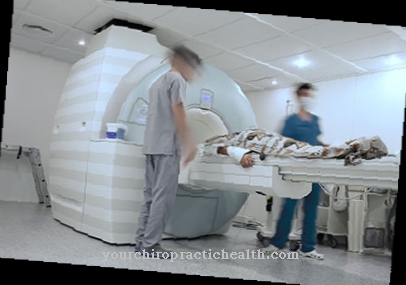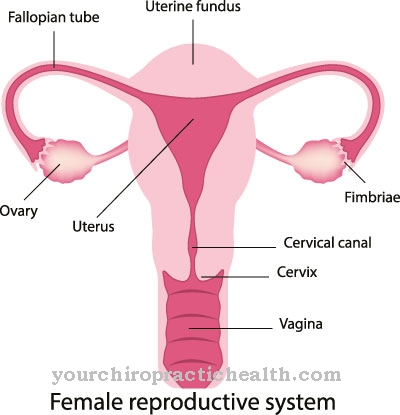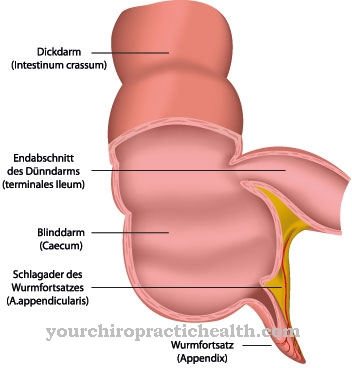At the Barraquer-Simons Syndrome it is a disease that usually appears for the first time in children or adolescents. The disease has a low prevalence in the average population. It is typical for Barraquer-Simons syndrome that fatty tissue is lost from the subcutaneous tissue in the area of the trunk and face.
What is Barraquer-Simons Syndrome?

© Alex - stock.adobe.com
The Barraquer-Simons syndrome is used by some of the doctors with the synonymous terms Progressive cephalo-thoracic lipodystrophy and Acquired partial lipodystrophy designated. Barraquer-Simons syndrome is usually associated with so-called lipatrophy in the sick person. In the case of Barraquer-Simons syndrome, this specifically involves the breakdown of fatty tissue from the area of the lower skin layers.
In Barraquer-Simons syndrome, this loss of fat primarily affects the upper half of the human body and here in particular the torso and face.
At the same time, hypertrophy develops in the adipose tissue of the thighs. As far as we know, more than 250 people are known to have Barraquer-Simons syndrome. It turns out that Barraquer-Simons syndrome is about three times more common in female than in male patients.
According to research to date, it cannot be assumed that Barraquer-Simons syndrome will occur more frequently in certain families. In the majority of cases, the first symptoms of Barraquer-Simons syndrome start in the face. As the disease progresses, it spreads to the neck, arms and shoulders.
Finally, the typical symptoms also occur in the chest area. The first scientific descriptions of Barraquer-Simons syndrome were made by several medical professionals. These include Simons, Mitchell and Barraquer Roviralta. Based on some of these doctors, the name of the syndrome, which is common today, arose.
causes
With regard to the current state of research, it is primarily genetic factors that emerge as possible causes for the development of Barraquer-Simons syndrome in the course of life. Numerous suspicions amount to a participation of special genetic mutations in the pathogenesis. The focus here is particularly on the gene called LMNB2.
This gene is responsible for coding lamin B2. This is a specific protein that is an important part of the membrane of cell nuclei. Basically, women are affected by Barraquer-Simons syndrome much more often than men, namely about three times more often. The reasons for this unequal impact on the sexes have not yet been conclusively clarified.
Symptoms, ailments & signs
Barraquer-Simons syndrome manifests itself in a wide range of different symptoms and characteristic signs of the disease. So-called lipodystrophy and hypoatrophy are particularly typical. In Barraquer-Simons syndrome, these phenomena primarily affect the fatty tissue of the lower skin areas.
It is also noticeable that the changes appear in the majority of cases in the upper part of the body, i.e. mainly on the trunk, thorax and face. In addition, Barraquer-Simons syndrome usually develops hypertrophy affecting the upper portion of the thigh. Basically, the first symptoms of Barraquer-Simons syndrome usually manifest themselves in the face of the sick person.
In addition, some patients affected by Barraquer-Simons syndrome suffer from diabetes mellitus, glomerulonephritis, so-called sensorineural hearing loss and hyperlipidemia. Epileptic seizures are also not uncommon in connection with Barraquer-Simons syndrome.
Characteristically, the symptoms of Barraquer-Simons syndrome first develop in children or adolescents. The symptoms usually spread from the face to other areas of the body. The shoulders, arms or the thorax are often affected. In some cases, patients with Barraquer-Simons syndrome have myopathy or have decreased intelligence.
Deviations in the normal metabolic balance are also known. Around 30 percent of those affected develop what is known as mesangio-capillary glomerulonephritis as part of Barraquer-Simons syndrome. Some of the patients have certain diseases of the immune system (so-called autoimmune diseases).
Diagnosis & course
The doctor bases his diagnosis on the clinical symptoms of Barraquer-Simons syndrome. Blood analyzes with laboratory evaluation of numerous parameters and characteristic values are particularly important. In the majority of cases, people suffering from Barraquer-Simons syndrome have certain antibodies.
At the same time, reduced concentrations of the corresponding complements can be detected. In addition to the actual diagnosis, the doctor also performs a differential diagnosis. He ruled out that Barraquer-Simons syndrome was not confused with Berardinelli-type lipodystrophy.
Complications
In most cases, Barraquer-Simons syndrome is primarily an optical complication. Fat tissue accumulates in the lower areas of the skin, which leads to inferiority complexes and a reduced self-esteem in many people. This can lead to depression and other mental disorders.
Barraquer-Simons syndrome also often leads to diabetes. In this case, those affected have to change their diet and control their blood sugar level. If the diet is followed, there are usually no further complications or complaints. In some cases, epileptic seizures and hearing loss also occur.
Since the syndrome is inherited, the child's development is also delayed. This leads to retardation and also to reduced intelligence in most patients. It is not uncommon for patients to then rely on the help of other people in their everyday lives. The immune system is also weakened, making it easier for infections and inflammations to occur.
It is possible to remove the malformations through surgical interventions so that the patient feels comfortable with his body. Diabetes can also be treated relatively well. In Barraquer-Simons syndrome, the kidneys often have to be checked for their function, as kidney failure is not uncommon.
Treatment & Therapy
The therapy of Barraquer-Simons syndrome is based on different approaches. Basically, cosmetic procedures are available to counteract the suffering of the affected patient due to the visual abnormalities of the disease. Glomerulonephritis also requires that the functioning and performance of the kidneys be checked regularly.
Possible impairments of the metabolism are treated depending on the symptom. For example, antihypertensive drugs or insulin are used here. Reliable statements about the prognosis of Barraquer-Simons syndrome are not yet possible. However, there seems to be a connection between the extent of the present nephropathy and the further course of the disease, which in the worst case results in kidney failure.
Doctors & therapists in your area
Outlook & forecast
The prognosis for Barraquer-Simons syndrome is poor. The cause of the disease has not yet been conclusively clarified. This makes it difficult to develop a healing therapy. Research suggests that it is a genetic disorder. This would make the search for a curative treatment more difficult because interference with human genetics is prohibited for legal reasons.
Since the disease is not considered to be curable, the efforts of medical professionals are focused on alleviating the accompanying symptoms. The aim is to improve the patient's quality of life. In some cases, drug treatment is used. It is a long-term therapy. Once the drug is discontinued, the patient's health deteriorates significantly.
The functioning of the organs should and must be ensured in some cases. Without medical care, in the worst case scenario, the patient can lose his or her life due to organ failure. Cosmetic interventions are also offered. These are used to support mental health, but have little effect on physical healing.
If the patient suffers from delays in development, specific methods to build up mental fitness can be used. The aim here is to help the patient cope with a lifestyle that is as independent and responsible as possible.
prevention
To this day, no preventive measures to prevent Barraquer-Simons syndrome have been tried.
You can do that yourself
According to the latest scientific findings, Barraquer-Simons syndrome is a congenital genetic defect that usually manifests itself in the young age of those affected or even in childhood. A salutary medical therapy is not yet possible as things stand today, but the accompanying symptoms can be alleviated by medical treatment.
With regard to quality of life and life expectancy, it is essential for those affected to put themselves in the hands of a doctor over the long term. This syndrome often results in metabolic changes or autoimmune diseases, as well as diabetes and a malfunction of the kidneys. These side effects need to be medically monitored and treated.
Patients should change their diet and monitor their blood sugar levels early on in order to counteract diabetes. The function of the kidneys must be checked regularly to rule out further complications. Without medical care and regular monitoring, this syndrome can lead to organ failure.
In Barraquer-Simons syndrome, changes in the fatty tissue in the lower layers of the skin lead to growths in the head and neck area. For most of those affected, these massive visual changes lead to a reduced self-esteem, social withdrawal and high levels of suffering.
It is advisable to go to psychological therapy at the first signs in order to counteract the growing psychological pressure that the symptoms of the disease can trigger. In many cases, cosmetic surgery is also advised to relieve the external symptoms and thus help the patient to regain more self-confidence and quality of life.
Since development is delayed in many of those affected by the syndrome in childhood, therapy for mental and intellectual abilities is started at an early age. In this way, the patients should achieve a qualitative, self-reliant and as independent life as possible. However, due to the developmental delays, those affected are often dependent on help in everyday life.
The therapeutic and medical approach in Barraquer-Simons syndrome thus mainly concentrates on alleviating external and internal symptoms and on maintaining the quality of life and independence of the patient.


.jpg)
























